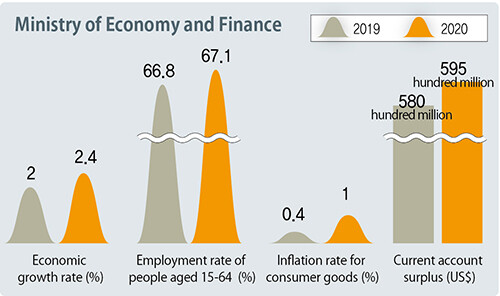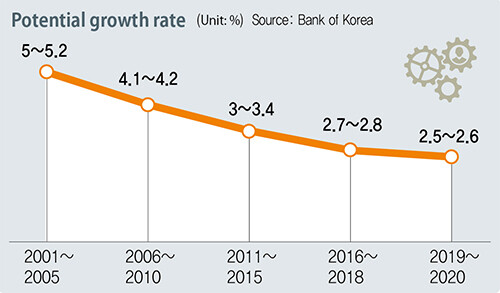hankyoreh
Links to other country sites 다른 나라 사이트 링크
S. Korean government to allot US$86 bln to public, private investments

Given doubts about whether South Korea’s economic growth rate will even reach 2% for 2019, the government has decided to focus all its efforts on engineering an economic rally next year, lining up 100 trillion won (US$86 billion) worth of public and private investments. Government statements show that its focus on boosting investment is based on an urgent sense of escaping from the low-growth trap.
But critics say the investment plan bears little resemblance to the “human-centered economy” that President Moon Jae-in and his administration have championed. Pushed into a corner over the economy, the Moon administration is clinging to a familiar, but outdated, growth paradigm. Since the efficacy of such short-term measures is unclear, there are also doubts about whether the economy will rebound swiftly.
During an expanded meeting of government ministers at the Blue House on Dec. 19, with Moon presiding, the government officially confirmed its economic policy plan for 2020, which largely consists of stimulating investment and improving the economic structure.

“The South Korean economy is competing with the world amid demographic changes and the structural challenges of low growth and polarization. I’m calling on the government to resolutely take the lead in doing everything possible to create even one more job, and to secure even one more investment,” Moon said.
The government is planning to concentrate its policies and capacity on revitalizing the economy. “We’ve placed our primary focus on increasing the recovery in investment so that we can create momentum for an economic rally, taking full advantage of the global economic recovery next year,” explained First Vice Minister of Strategy and Finance Kim Yong-beom.
One of the government’s key goals for economic growth next year is increasing the private sector’s contribution to growth by fostering investment. More specifically, the government plans to arrange 25 trillion won (US$21.5 billion) in private-sector investments and 15 trillion won (US$12.9 billion) in projects funded by private capital, while increasing investment by public enterprises from this year’s level of 55 trillion won (US$47.29 billion) to 60 trillion won (US$51.59 billion) next year.
The government has also created financial and tax-based incentives for private-sector investment, including a financial support program, worth 4.5 trillion won (US$3.87 billion), for promoting facility investment. This program will provide non-chaebol firms, both large and small, with loans with interest rates as low as 1.5% and also dish out over 1 trillion won (US$859.74 million) in subsidized loans for environment and safety investment. “Smart factories” will be added to the “productivity-enhancing facilities” that are eligible for tax breaks (2%, 5%, and 10% for SMEs, larger firms, and chaebol) under this year’s revision of the tax code. Furthermore, the expiration date for an accelerated depreciation program that boosts depreciation in the initial investment phase will be given a six-month extension, from the end of this year until the middle of next year.

In addition, the government is working on a threefold package aimed at boosting momentum for innovative growth, which will include tax breaks on investment in 5G mobile technology as well as halving registration and licensing taxes on newly built wireless stations. There’s also a stimulus package aimed at increasing domestic consumption. Spenders will be allowed to deduct 30% of domestic lodging expenses from their taxable income and to get VAT refunds during an event called Korea Sale Festa. The government is also planning to announce partial rebates on purchases of highly efficient electronic devices during the first quarter of next year.
Through such investment stimulus measures, the government is determined to orchestrate an economic rally next year. The government projects that the economy will grow by 2% this year and 2.4% next year. These figures assume an improvement in conditions overseas, with the global economic growth rate buoyed by emerging economies and the global trade growth rate rebounding from 1.1% this year to 3.2% in 2020.
But the goals of these programs are likely to prove controversial. “All they’ve announced is the target amount of investment, and little thought has apparently been given to where resources are being distributed. The government seems so desperate to fix the economy that it’s returning to a policy of factor input-driven growth,” said Cho Yeong-cheol, a guest professor of economics at Korea University. He proposed instead a “Green New Deal” that would seek to tackle climate change.
Other experts see these programs as inevitable. “This reflects a powerful determination to energize private-sector investment through tax breaks and any other options available to the government. Considering that policymakers are obliged to consider short-term difficulties, I think this is the right course,” said Kim Seong-taek, head of economic projections at the Korea Development Institute.
Even so, doubts have been raised about policy effectiveness. “Their approach is not facilitating the emergence of new companies that can make large-scale investments and raise productivity, but simply pushing the chaebol to invest more money. It’s unclear how effective more facility investment will be,” said Ha Jun-gyeong, a professor of economics at Hanyang University.
“Short-term economic measures are needed through the first half of next year, when the economy will bottom out, but I’m not seeing many measures that will have an actual effect during that period. Since the government is focused on medium- and long-term projects, I don’t think it will be able to achieve its projected growth rate of 2.4%,” said Ju Won, head of research at the Hyundai Research Institute.
By Noh Hyun-woong and Lee Kyung-mi, staff reporters
Please direct comments or questions to [english@hani.co.kr]

Editorial・opinion
![[Column] Park Geun-hye déjà vu in Yoon Suk-yeol [Column] Park Geun-hye déjà vu in Yoon Suk-yeol](https://flexible.img.hani.co.kr/flexible/normal/500/300/imgdb/original/2024/0424/651713945113788.jpg) [Column] Park Geun-hye déjà vu in Yoon Suk-yeol
[Column] Park Geun-hye déjà vu in Yoon Suk-yeol![[Editorial] New weight of N. Korea’s nuclear threats makes dialogue all the more urgent [Editorial] New weight of N. Korea’s nuclear threats makes dialogue all the more urgent](https://flexible.img.hani.co.kr/flexible/normal/500/300/imgdb/original/2024/0424/7317139454662664.jpg) [Editorial] New weight of N. Korea’s nuclear threats makes dialogue all the more urgent
[Editorial] New weight of N. Korea’s nuclear threats makes dialogue all the more urgent- [Guest essay] The real reason Korea’s new right wants to dub Rhee a founding father
- [Column] ‘Choson’: Is it time we start referring to N. Korea in its own terms?
- [Editorial] Japan’s rewriting of history with Korea has gone too far
- [Column] The president’s questionable capacity for dialogue
- [Column] Are chaebol firms just pizza pies for families to divvy up as they please?
- [Column] Has Korea, too, crossed the Rubicon on China?
- [Correspondent’s column] In Japan’s alliance with US, echoes of its past alliances with UK
- [Editorial] Does Yoon think the Korean public is wrong?
Most viewed articles
- 1[Column] Park Geun-hye déjà vu in Yoon Suk-yeol
- 2Thursday to mark start of resignations by senior doctors amid standoff with government
- 3N. Korean hackers breached 10 defense contractors in South for months, police say
- 4Kim Jong-un expressed ‘satisfaction’ with nuclear counterstrike drill directed at South
- 5[Editorial] New weight of N. Korea’s nuclear threats makes dialogue all the more urgent
- 6Will NewJeans end up collateral damage in internal feud at K-pop juggernaut Hybe?
- 7[Column] ‘Choson’: Is it time we start referring to N. Korea in its own terms?
- 8[Editorial] Japan’s rewriting of history with Korea has gone too far
- 9[Cine feature] A new shift in the Korean film investment and distribution market
- 10[Column] The president’s questionable capacity for dialogue